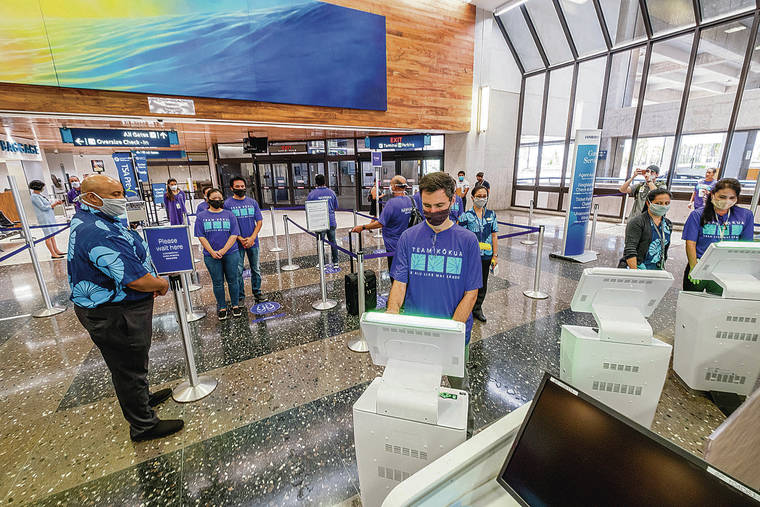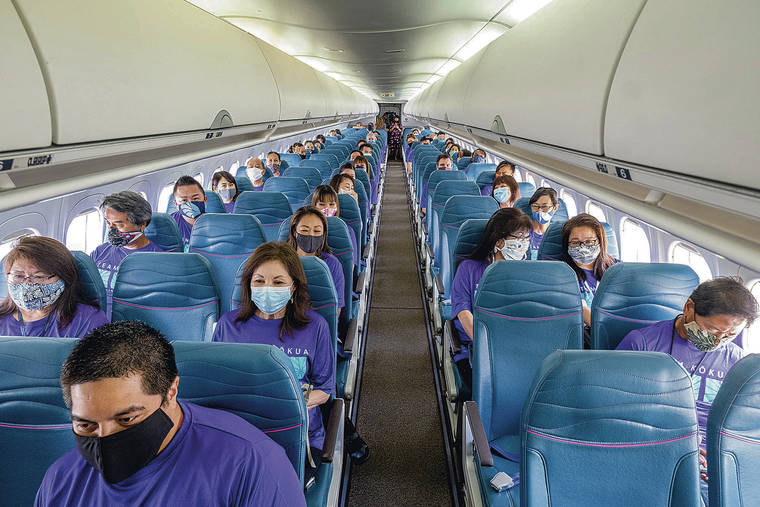Hawaiian Airlines plans to shrink 15% to 25%

DENNIS ODA / JUNE 1
Hawaiian Airlines will further reduce staff after a large second-quarter loss. Hawaiian Airlines staff demonstrate how future passengers will check in and get their tickets at the kiosk at Daniel K. Inouye International Airport.

DENNIS ODA / JUNE 1
Hawaiian Airlines staff demonstrate how passengers will be seated in planes, with the middle seat not being used, to help reduce contact between passengers.


Hawaiian Airlines is moving to raise cash and reduce staffing after reporting a significant second-quarter loss that continued the financial harm that emerged earlier this year from COVID-19 fears and containment policies.
News of the coming changes came Tuesday during an investor earnings call where parent Hawaiian Holdings Inc. reported a quarterly loss of $106.9 million, or a loss of $2.33 a share. During last year’s second quarter, Hawaiian had net income of more than $57.8 million, or $1.21 a share.
The carrier’s adjusted net income, including CARES Act deductions and other changes, was a loss of $174.7 million, or $3.81 a share. Revenue fell to just over $60 million, a nearly 92% drop from the $712 million-plus that it realized in the second quarter of 2019. Its stock rose 11 cents to $13.17 before the earnings were announced after the close of trading.
Hawaiian reported a second-quarter daily cash burn of about $3.3 million.
“The second quarter was an incredibly challenging period for our company and for the entire industry as we continue to face the unprecedented demand destruction due to the COVID-19 pandemic,” Peter Ingram, president and CEO of Hawaiian Airlines, said during the conference call. “In our home state of Hawaii, we had a 14-day quarantine in place for incoming travelers throughout the quarter, leading us to operate a fraction of the schedule that we planned at the beginning of the year. The human toll of the virus was also driven home last week with the passing of one of our longtime flight attendants.”
Hawaiian reported last week that Jeff Kurtzman, 60, a Hawaiian flight attendant since 1986, died after testing positive for COVID-19. Kurtzman was among 17 Hawaiian employees who tested positive for COVID-19 who were part of a training cluster.
Don't miss out on what's happening!
Stay in touch with breaking news, as it happens, conveniently in your email inbox. It's FREE!
New COVID-19 cleaning and social distancing protocols also are expected to continue cutting into profits. The carrier has pledged through at least September to limit the capacity of available seats on all aircraft to no higher than 70% to allow for greater physical distancing.
The pandemic’s economic costs also are exacting high human costs. Hawaiian already has taken steps to reduce staffing levels through voluntary unpaid leave, voluntary exit packages and early retirement packages. It has instituted a hiring freeze, except for essential positions, and has reduced executive pay by 10% to 50%.
“While we don’t know the pace of the return to demand for travel to Hawaii, we know that it will occur. But we also know that it will take years, not months, to get back to pre-COVID-19 levels,” Ingram said. “With an uncertain demand recovery timeline, our primary planning scenario focuses on being a smaller airline by about 15% to 25% next summer compared to 2019 levels.”
In accordance with this goal, Ingram said Hawaiian is taking steps to “right-size our company” and that the “key to managing this is adjusting our staffing levels.”
Over the next several days Hawaiian will be releasing Worker Adjustment and Retraining Notification Act notices to employees at risk of being affected by an undisclosed number of involuntary furloughs, Ingram said.
“Having to shrink the company that our company has worked so painstakingly to build is heartbreaking, but it is essential to preserve the viability, competitiveness and success of our business over the long term,” he said. “We will manage through this and emerge strongly.”
Hawaiian’s reductions come despite federal aid. Through June 30 the company has received $214.2 million in grants and $49 million in loans from the CARES Act. It expects to receive an additional $29.2 million this month.
The company also reported that it’s trying to increase liquidity this month by entering into additional financial transactions. It’s raised $114 million through the sale and leaseback of two Airbus A321neo aircraft. It also signed a nonbinding letter of intent with the U.S. Treasury Department pursuant to potentially receive up to $364 million in Economic Relief Program loans offered under the CARES Act. Hawaiian has until March to decide how much of the available ERP funds to borrow.
Hawaiian, which is the state’s largest carrier and one of Hawaii’s largest employers with more than 7,400 in March, first saw demand begin dropping early in the year when the U.S. government imposed restrictions on Chinese arrivals, followed by hits to its South Korea and Japan routes. Losses accelerated in mid-March after governments in Australia, New Zealand, Tahiti, American Samoa and Hawaii implemented self-isolation or quarantine policies for incoming arrivals.
The Hawaii Tourism Authority reported Tuesday that only 525 of the 2,671 passengers who arrived on 36 incoming flights Monday were visitors. Before COVID-19 the state typically welcomed up to 35,000 passengers a day, most of them visitors.
Tuesday’s earnings brought Hawaiian’s loss during the first six months of the year to more than $251 million, or a loss of $5.47 a share. During the same period in 2019, the carrier posted net income of more than $94 million, or $1.96 per share.
Hawaiian was set to resume most of its mainland routes and increase its neighbor island schedule in response to the planned reopening of out-of-state tourism to Hawaii on Aug. 1. However, the carrier pulled back from those plans after Gov. David Ige delayed the start of a pre-arrivals testing program until at least Sept. 1 — a date that gets less certain as COVID-19 case counts climb in Hawaii and on the mainland.
“On the surface pre-testing is an elegant solution to preserve Hawaii’s low COVID incidents while simultaneously stimulating our home state’s devastating economy,” Ingram said. “There are many details that remain uncertain that will, however, affect the ability of a potential traveler to access tests and the corresponding level of demand that we can expect.”
Ingram said Hawaiian remains engaged with state and county officials about the process.
“A priority for us is for the state to finalize details about applicable tests and approved providers so that we can provide information to potential guests seeking clarity about what is required,” he said.
Ingram said it’s also problematic for the carrier that its international service has remained suspended due to restrictions on inbound travel.
On Monday it was announced that Oahu could see a small boost in tourism since Hawaii is under consideration on an exclusive list of 12 countries and regions that Japanese leaders are vetting for the resumption of safe international travel.
But even if the Japan “travel bubble” advances, it’s still uncertain how much improvement it could bring. Many details about this program are still pending, just as they are for Hawaii’s pre-arrivals testing plan.
Second-quarter loss
$106.9 million
Year-earlier net
$57.8 million



